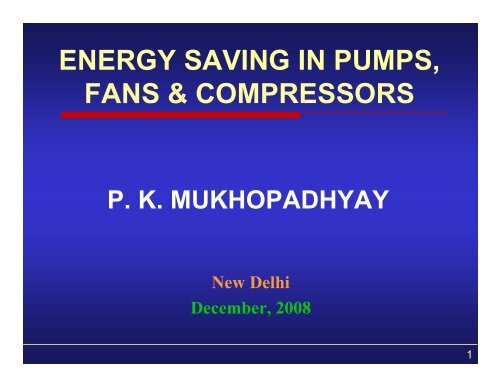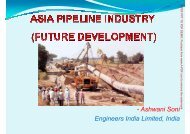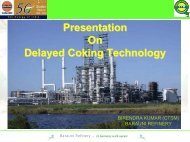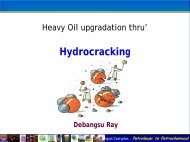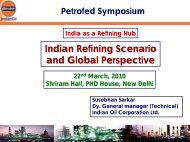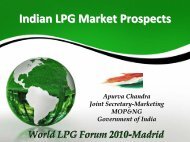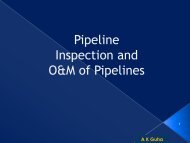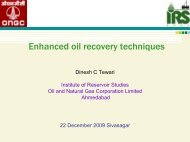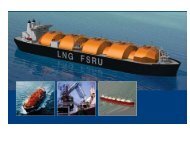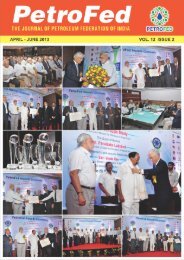energy saving in pumps, fans & compressors - petrofed.winwinho...
energy saving in pumps, fans & compressors - petrofed.winwinho...
energy saving in pumps, fans & compressors - petrofed.winwinho...
Create successful ePaper yourself
Turn your PDF publications into a flip-book with our unique Google optimized e-Paper software.
ENERGY SAVING IN PUMPS,<br />
FANS & COMPRESSORS<br />
P. K. MUKHOPADHYAY<br />
New Delhi<br />
December, 2008<br />
1
Energy – Pumps<br />
Pump<strong>in</strong>g – 25-50% Energy <strong>in</strong> plants<br />
– 20% World Electric Energy<br />
9%<br />
27%<br />
64%<br />
Energy<br />
Repair<br />
Cost<br />
Life Cycle Cost Analysis<br />
2
Energy Sav<strong>in</strong>g <strong>in</strong> Pumps<br />
Pump<strong>in</strong>g System<br />
-L<strong>in</strong>e Size<br />
-Fitt<strong>in</strong>gs<br />
- Valves<br />
- Pumps<br />
-Motors<br />
- Drives<br />
L<strong>in</strong>e Size<br />
- Velocity Limits<br />
High – Errosion, NPSHA, Noise, Standards<br />
Low – Sedimentation<br />
--- M<strong>in</strong>imise Life cycle cost<br />
3
Energy Sav<strong>in</strong>g <strong>in</strong> Pumps<br />
P <strong>in</strong> Control Valves for same size & flow rate<br />
4
Life Cycle Cost – Pump<strong>in</strong>g System<br />
COST<br />
LINE DIAMETER<br />
5
Pump System Interaction<br />
Pump Curve<br />
Operat<strong>in</strong>g Po<strong>in</strong>t<br />
HEAD, FT<br />
System Curve<br />
Capacity, GPM<br />
6
Typical Pump Curves<br />
Pump Curve<br />
Operat<strong>in</strong>g Po<strong>in</strong>t<br />
Head<br />
Efficiency<br />
Efficiency<br />
System Curve<br />
BEP<br />
NPSHR<br />
BHP NPSHR<br />
BHP<br />
Capacity<br />
7
Pump Overdesign<br />
‣ Overdesign result<strong>in</strong>g actual<br />
operation away from BEP<br />
<br />
BID evaluation-efficiency<br />
difference of ½ to 1%<br />
<br />
System clearance<br />
}<br />
Lighter shaft To Check 8
Handl<strong>in</strong>g Pump Overdesign<br />
& Part-Load with Time<br />
Approaches<br />
Methods<br />
– Shift Pump Curve<br />
– Shift System Curve<br />
– Shift Both<br />
– Throttl<strong>in</strong>g by Control Valves<br />
– Bypass<strong>in</strong>g Pump<br />
– Two <strong>pumps</strong> <strong>in</strong> series<br />
– Start-Stop Operation<br />
– Variable Speed Operation<br />
– 2-Speed Motor<br />
9
Part Load Operation<br />
<br />
Throttl<strong>in</strong>g by Control Valve<br />
<br />
<br />
<br />
Conventional Method<br />
High Energy<br />
Valve Wear<br />
10
Part Load Operation<br />
<br />
Bypass<strong>in</strong>g Pump<br />
<br />
<br />
<br />
High Energy<br />
Temperature Rise<br />
Valve Wear<br />
11
Part Load Operation<br />
Aff<strong>in</strong>ity Laws<br />
Change<br />
Constant<br />
Cas<strong>in</strong>g`<br />
RPM N<br />
IMP D<br />
Q 1 D 2<br />
2<br />
Q 2 Q 1 N 2<br />
H 2 H 1 N 2<br />
2<br />
H 1 D 2<br />
N 1<br />
D 1<br />
BHP BHP 1<br />
N<br />
3<br />
2 2 BHP 1<br />
D 2<br />
3<br />
N 1<br />
D1<br />
N 1<br />
Assumes Constant Efficiency<br />
IMP. D<br />
RPM N<br />
SAME<br />
D 1<br />
<br />
<br />
<br />
<br />
Two Pumps <strong>in</strong> parallel<br />
Start-Stop operation<br />
By chang<strong>in</strong>g N at<br />
constant D, efficiency is<br />
constant if system is<br />
ma<strong>in</strong>ly friction load. If<br />
system conta<strong>in</strong>s static<br />
head efficiency loss will<br />
occur.<br />
For chang<strong>in</strong>g D efficiency<br />
is constant if D change is<br />
less than 5%. For 25%<br />
change efficiency drop<br />
can be 2% or more<br />
depend<strong>in</strong>g on N s .<br />
12
Effect of RPM Change of Efficiency<br />
Pump Curve<br />
13
Match<strong>in</strong>g pump & system curves<br />
By Variable speed drive<br />
Head, %<br />
Power, %<br />
Capacity, %<br />
14
Part Load Operation<br />
<br />
<br />
Energy efficiency is best with RPM change and for<br />
system with ma<strong>in</strong>ly frictional loss.<br />
Typical <strong>energy</strong> <strong>sav<strong>in</strong>g</strong><br />
Full Load<br />
Part Load<br />
Power for part Load<br />
Throttl<strong>in</strong>g<br />
Variable speed drive<br />
% <strong>sav<strong>in</strong>g</strong> VSD<br />
GPM<br />
3600<br />
2400<br />
FT<br />
180<br />
152<br />
HP<br />
165<br />
118<br />
28<br />
2 – Speed Motor<br />
If part-loads are <strong>in</strong> two regions 2-speed motor is effective.<br />
Typical speeds, RPM<br />
1750/1150, 1750/850, 1150/850, 3500/1750<br />
Cheaper than VSD<br />
15
Part–Load Operation<br />
2-SPEED MOTOR AND THROTTLING<br />
16
Pump Selection<br />
<br />
<br />
<br />
Specific Speed N s = N√Q<br />
(g∆H) ³⁄<br />
For Simplicity g is dropped N s<br />
= N√Q<br />
(∆H) ³⁄<br />
Based on Anderson’s Work<br />
Efficiency η =0.94 – 0.08955 Q(gpm) . X<br />
N(rpm)<br />
– 0.29 Log º 2286 <br />
Ns<br />
-0.21333<br />
2<br />
X = 140<br />
ξ(µ - <strong>in</strong> ) ≈ 1<br />
17
BEP of Centrifugal <strong>pumps</strong> as function<br />
of NS,Q/N & Shape<br />
18
BEP of Pumps – Flowserve corp<br />
19
Change of Pump Efficiency on Part-Load<br />
20
Effects of Viscous Fluid on Pump Curve<br />
21
Achiev<strong>in</strong>g High BEP<br />
Avoid N s < 1000<br />
N s Too High<br />
BEP Highest N s 2500<br />
How to achieve higher BEP?<br />
N s = N√Q<br />
(∆H) ³⁄<br />
N up to 3600<br />
NPSHR<br />
∆H is large, use Multistage pump<br />
22
Vendor Offer Evaluation<br />
<br />
<br />
Compare offer BEP with calculated values. If large mismatch to<br />
<strong>in</strong>vestigate impeller type, clearance, surface roughness, etc.<br />
Initial Test Run<br />
Design & Actual – Operat<strong>in</strong>g po<strong>in</strong>ts, efficiency. Need for<br />
throttl<strong>in</strong>g. Consider<br />
Change rotor dia<br />
Trim Rotor<br />
Change Rotor Width<br />
Different no of blades<br />
Blade discharge Angles<br />
Orifice <strong>in</strong> discharge<br />
Impeller with angle trim at periphery<br />
23
Change Rotor Dia<br />
24
Rotor Trim Correction<br />
25
Efficiency %<br />
60<br />
40<br />
20<br />
0<br />
26<br />
80<br />
X 10<br />
Change Rotor Width<br />
Capacity GPM X 100<br />
100<br />
Head feet
Change Blade Number<br />
27<br />
Capacity, %<br />
Head and Efficiency., %
Effect of No of Vanes & Discharge Angle<br />
Head & Efficiency, %<br />
Capacity, %<br />
28
Impeller With Angle-Trim at Peripheral<br />
29
Pump Performance with Orific <strong>in</strong> Discharge<br />
¼ORIF<br />
Head, Ft<br />
Capacity, GPM<br />
30
Performance Change with Orifice<br />
Head, %<br />
B.H.P., %<br />
Capacity, %<br />
31
Increas<strong>in</strong>g Pump Capacity<br />
<br />
<br />
Underfil<strong>in</strong>g vane tips<br />
Remov<strong>in</strong>g metal from volute<br />
tongue<br />
Performance after underfil<strong>in</strong>g vane tips<br />
Underfil<strong>in</strong>g vane tips<br />
32
Remov<strong>in</strong>g Metal from Volute Tongue<br />
33
Performance after metal removal<br />
from volute tongue<br />
Head and Efficiency, %<br />
Q = Capacity Normal<br />
Q1 = Capacity after volute chipp<strong>in</strong>g<br />
A =Projected volute <strong>in</strong>let area normal<br />
A1 = Projected volute <strong>in</strong>let area after chipp<strong>in</strong>g<br />
34
Different Variable Speed Drives<br />
<br />
<br />
<br />
Permanent magnet adjustable speed drive<br />
S<strong>in</strong>gle unit adjustable speed drive<br />
AC adjustable voltage drive<br />
Wound-Rotor <strong>in</strong>duction motors<br />
• Liquid rheostat controls<br />
• Tirastat II secondary controls<br />
• Contact secondary controls<br />
Adjustable frequency drives<br />
• Pulse width modulation frequency <strong>in</strong>verters<br />
• Solid state frequency <strong>in</strong>verters<br />
• Flux vector drives<br />
Modified Kraemer drives<br />
DC motor with SCR power supply drives<br />
Variable speed fluid drives<br />
35
Variable Speed Drives<br />
Permanent magnet adjustable speed drives<br />
• Number of units up to 400HP <strong>in</strong> use<br />
• Problems of dissipat<strong>in</strong>g heat losses<br />
Adjustable frequency drives<br />
• Widely used <strong>in</strong> units below 1000 HP<br />
• Used over 10,000 HP units<br />
• Sophisticated electronic system<br />
Variable speed fluid drives<br />
• Used for 400 – over 40,000 HP units<br />
36
Pump test at frequent <strong>in</strong>tervals<br />
Performance deterioration with time<br />
Need for repair or change of components<br />
<strong>in</strong>clud<strong>in</strong>g impellers<br />
37
Efficiency of variable-speed drives<br />
Efficiency, %<br />
Design Speed, %<br />
38
Efficiency of Electric Motors (Four-Pole)<br />
Premium Efficiency Motor<br />
Efficiency, %<br />
EPAct Motor<br />
Typical Older Motor<br />
Horsepower<br />
39
Energy Consumption <strong>in</strong> Fans<br />
System Design<br />
Choice of type<br />
• Efficiency<br />
• Reliability<br />
• Noise<br />
Centrifugal Type<br />
Airfoil BEP > 80%<br />
Backward <strong>in</strong>cl<strong>in</strong>ed / Curved BEP > 75%<br />
Axial<br />
Vane Axial BEP >75%<br />
40
Handl<strong>in</strong>g Fan Over design & Part Load<br />
Throttl<strong>in</strong>g by dampers<br />
Orifice <strong>in</strong> discharge<br />
Inlet vane control<br />
Speed control<br />
• Variable Speed Motor<br />
• 2 Speed Motor<br />
Variable Pitch<br />
• Vane Axial Fan<br />
41
Outlet Damper & Variable Speed Control<br />
42
Inlet Vane Control on Backward<br />
Curved Centrifugal Fan<br />
43
Blade Pitch Change on Vaneaxial Fan<br />
44
Power Consumption for Part-Load<br />
Conditions<br />
45
Power Consumption for Part-Load<br />
Conditions …..<br />
46
Power Consumption for Part-Load by<br />
Different Methods<br />
47
Compressor<br />
System Design<br />
Choice of Type<br />
In FCC Service<br />
• S<strong>in</strong>ce 1950 Centrifugal Compressors<br />
• Presently axial <strong>compressors</strong> turndown 75% with<br />
little efficiency loss<br />
• Efficiency 12% higher<br />
48
Handl<strong>in</strong>g Overdesign & Part Load<br />
Inlet damper control<br />
Bypass valve control<br />
Inlet vane control<br />
Variable speed control<br />
Diffuser vane control<br />
49
Types of System Curves<br />
50
Control of a Gas Compressor<br />
Suction Volume V o 5.5 M ³ /S @ 3.63 BAR & 37°C<br />
Pressure Ratio (P d /P s ) o 9.73<br />
No of Stages 7<br />
Power P io<br />
51
Part Load Operation<br />
<br />
Constant Pressure Ratio<br />
P d /P s =9.73<br />
Flow (V/V o<br />
) – 0.75<br />
Regulation<br />
Power<br />
P i<br />
/P io<br />
REL<br />
Power<br />
Surge<br />
V s /V o<br />
Speed<br />
Variation<br />
0.78<br />
100<br />
0.67<br />
Suction<br />
Throttl<strong>in</strong>g<br />
0.83<br />
107<br />
0.65<br />
Adjustable Inlet<br />
Vane<br />
0.80<br />
103<br />
0.60<br />
By Pass<strong>in</strong>g<br />
1.00<br />
128<br />
52
Part Load Operation<br />
<br />
Parabolic System Resistance Curve<br />
P d /P s -9.73<br />
Flow (V/V o ) – 0.85<br />
Regulation<br />
Speed Variation<br />
Suction<br />
Throttl<strong>in</strong>g<br />
Adjustable Inlet<br />
Vane<br />
By Pass<strong>in</strong>g<br />
Power<br />
P i /P io<br />
0.62<br />
0.75<br />
0.73<br />
0.90<br />
Relative<br />
Power<br />
100<br />
121<br />
118<br />
145<br />
53
Power Input <strong>in</strong> Refrigeration<br />
Compressors at Part-Load<br />
GAS COMPRESSION POWER INPUT, %<br />
SPEED CONTROL<br />
VANE CONTROL<br />
SYSTEM VOLUMETRIC FLOW, %<br />
54
Part Load Operation Comparison of<br />
Power Consumption<br />
At constant P d / P s speed variation is only slightly<br />
better than adjustable vane & suction throttl<strong>in</strong>g<br />
With parabolic system resistance curve speed<br />
variation is superior to adj. <strong>in</strong>let vane & suction<br />
throttl<strong>in</strong>g<br />
For refrigeration compressor speed control & adj. <strong>in</strong>let<br />
vane are superior <strong>in</strong> different ranges.<br />
55
Summary of Energy Sav<strong>in</strong>g<br />
56


